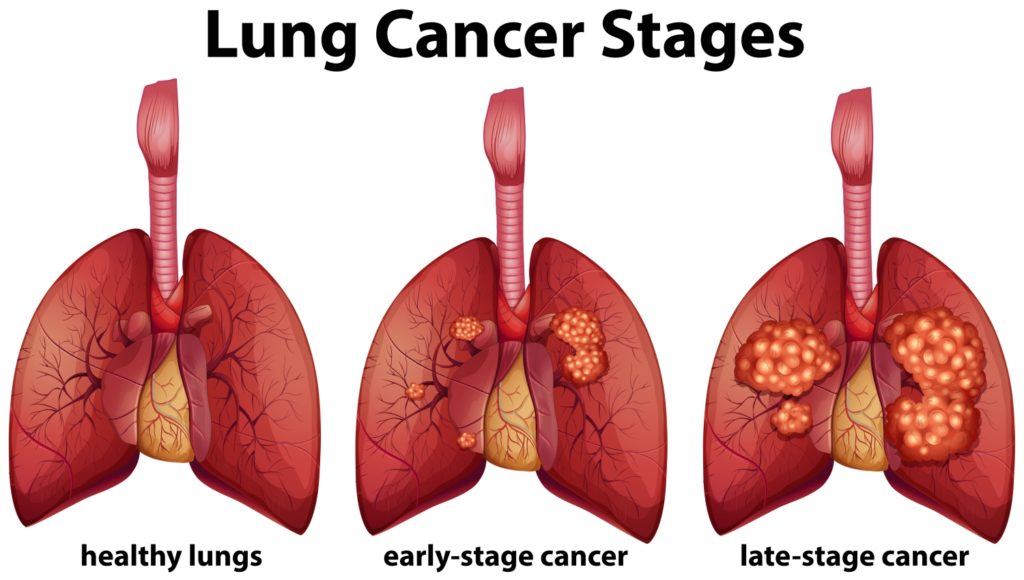Last Updated on September 19, 2024
Contents
- What is Lung Cancer?
- Early Symptoms of Lung Cancer
- Some Tests That Help To Diagnose Lung Cancer
- Staging of Lung Cancer
- Three standard forms of treatment
- Taking Steps to Reduce Lung Cancer Risk
What is Lung Cancer?
Lung cancer is the most preventable type of cancer but one of the most difficult to treat. More than 87% of Lung Cancers are related to smoking.
Cancer occurs when, for an unknown reason, cells divide without control or order to eventually create a tumor. Certain circumstances increase the risk of lung cancer.
- Cigarette smoke contains chemicals (toxins) that damage the genetic structure (DNA) of the body’s cells. The damage to DNA causes cells to become cancerous. Even smoking one cigarette daily can increase the risk of lung cancer, and risk increases with each cigarette smoked. People who smoke cigars have an even higher risk. The good news is that risk begins to drop soon after quitting.
- Second hand smoke has also been shown to increase lung cancer risk.
- Working with materials such as
- asbestos, arsenic, nickel, and petroleum products can increase the risk of lung cancer.
- Living in a polluted city for more
- than 10 years may slightly increase the risk of lung cancer, as well as exposure to a naturally occurring gas called radon.
Early Symptoms of Lung Cancer
Unfortunately, symptoms of lung cancer do not normally become evident until the disease has progresses somewhat. Still, it is very important to identify symptoms as early as possible in order to have the best possible outcome with treatment. Symptoms of lung cancer can include the following:
- A cough that doesn’t go away Shortness of breath
- Chest, shoulder, upper back or arm pain that doesn’t go away
- Repeated bouts of pneumonia or bronchitis
- Repeated bouts of pneumonia or bronchitis
- Coughing up blood
- Hoarseness
- Wheezing
- Swelling of the face and neck
- Loss of appetite
- Unexplained weight loss
- Unusual tiredness
Some Tests That Help To Diagnose Lung Cancer
- Chest x-rays produce an image of the chest and its internal structures.
- Sputum cytology involves the collection of sputum (mucus coughed up from the lungs) in order to look for cancer cells under a microscope.
- Bronchoscopy is a procedure.
- that uses a thin lighted tube inserted through the nose or mouth to look at the windpipe and air assages that lead to the lung. A biopsy may also be taken.
- Thoracentesis involves removal of fluid from the space between the lungs and chest wall (pleural
- cavity). The cells are then checked to see if any are cancerous.
Staging of Lung Cancer
Staging of lung cancer refers to how far it has progressed and is usually referred to by number (i.e. 0, 1, 2, 3, 4). Doctors need to understand what stage the cancer is at in order to recommend appropriate treatment. The higher numbers are used for cancers that have spread to nearby lymph nodes (in the area between the lungs that contain the heart, major blood vessels, and other structures, or to the lymph nodes on the pposite side of the chest or in the lower neck) but to other parts of the body. Stage 4 cancer has spread to other parts of the body or to another lobe of the lung.
Treatment The type of treatment to be used depends on the type, grade and stage of cancer. There are two basic types of lung cancer. One is called small cell lung cancer (Oat cell cancer) and the other is non-small cell lung cancer. Non-small cell lung cancer is much more common and spreads to different parts of the body more slowly. Squamous cell carcinoma, adenocarcinoma and large cell carcinoma are types of non-small cell lung cancer.
There are three standard forms of treatment:
Surgery – may be used to remove the area of the lung that contains lung cancer. If all the cancer is removed, the disease will be cured. Types of surgery include wedge resection (surgery to remove only a mall part of the lung), lobectomy (surgery to remove a whole lobe of the lung, and pneumonectomy (surgery to remove one whole lung). Laser surgery uses a narrow beam of high-energy light to remove abnormal cells of lesions. During surgery, the doctor will also remove lymph nodes to see if they contain any cancerous cells.
Radiation Therapy – This technique involves the use of x-rays or other types of radiation to kill cancer cells and shrink tumors. Radiation may be delivered by rays from a machine, or by materials that deliver adiation internally by placing them in a thin plastic tube and into the area where cancer cells are found. Radiation is used after surgery as well as in combination with chemotherapy.
Chemotherapy – Certain drugs can kill cancer cells. Some chemotherapy drugs taken by mouth and others are injected. Chemotherapy is used in conjunction with surgery in more advanced stages of the disease and in all stages of small cell lung cancer. Because Chemotherapy kills some normal cells as well as cancer cells, it can cause associated side effects (e.g. hair loss, mouth sores). It can also cause nausea in some cases, which can be controlled in large measure by anti-nausea medications.
Taking Steps to Reduce Lung Cancer Risk
- Staying away from tobacco smoke is by far the best preventive measure against lung cancer. Smoking accounts for at least 80% of all new lung cancer cases in women and 90% of those in men. Second-hand smoke has also been shown to increase the risk of lung cancer.
- Research has shown that people who eat at least 3 servings of fruit or vegetables a day have a lower risk of lung cancer. Examples of one serving of vegetables include one cup of raw leafy greens like lettuce or spinach or a ½ cup of other vegetables, raw or cooked. Examples of one serving of fruit include one medium – sized piece of fruit, or a ½ cup of small or cut-up fruit, or a ½ cup of 100% fruit juice.
Written by: Winter Rose
Copyright © by www.siyalla.com
[Earlier our website was www.ehealthut.com]

